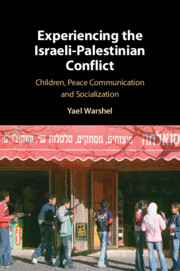Book contents
- Experiencing the Israeli-Palestinian Conflict
- Experiencing the Israeli-Palestinian Conflict
- Copyright page
- Dedication
- Contents
- Figures
- Tables
- Acknowledgments
- Note on the Text
- Abbreviations
- Introduction
- Part I The Encoding and Production of Israeli and Palestinian Sesame Street
- Introduction to Part I: Encoding and Production Methodologies
- 1 The Israeli-Palestinian Ethno-political Nationalist Conflict, the Arab-Israeli Multistate Conflict and Israeli and PalestinianSesame Street’s Disengagement with These Conflicts
- 2 The Modern World, or Interstate, System
- 3 The Encoding Process for Seasons One and Two of Israeli and Palestinian Sesame Street
- Part II Audience Reception of Israeli and Palestinian Sesame Street
- Part III Situating the Reception of Israeli and Palestinian Sesame Street in Mundane, Intractable Conflict Zone Practices
- Part IV Conclusions and Recommendations to Improve Peace Communication Research, (Evidence-Based) Practice and Conflict Intractability Interpretation
- Book part
- References
- Index
- Plate Section (PDF Only)
1 - The Israeli-Palestinian Ethno-political Nationalist Conflict, the Arab-Israeli Multistate Conflict and Israeli and PalestinianSesame Street’s Disengagement with These Conflicts
from Part I - The Encoding and Production of Israeli and Palestinian Sesame Street
Published online by Cambridge University Press: 08 July 2021
- Experiencing the Israeli-Palestinian Conflict
- Experiencing the Israeli-Palestinian Conflict
- Copyright page
- Dedication
- Contents
- Figures
- Tables
- Acknowledgments
- Note on the Text
- Abbreviations
- Introduction
- Part I The Encoding and Production of Israeli and Palestinian Sesame Street
- Introduction to Part I: Encoding and Production Methodologies
- 1 The Israeli-Palestinian Ethno-political Nationalist Conflict, the Arab-Israeli Multistate Conflict and Israeli and PalestinianSesame Street’s Disengagement with These Conflicts
- 2 The Modern World, or Interstate, System
- 3 The Encoding Process for Seasons One and Two of Israeli and Palestinian Sesame Street
- Part II Audience Reception of Israeli and Palestinian Sesame Street
- Part III Situating the Reception of Israeli and Palestinian Sesame Street in Mundane, Intractable Conflict Zone Practices
- Part IV Conclusions and Recommendations to Improve Peace Communication Research, (Evidence-Based) Practice and Conflict Intractability Interpretation
- Book part
- References
- Index
- Plate Section (PDF Only)
Summary
Describes the logic behind Sesame Street interventions’ design and goals, through the performance of concise encoding and production studies of the text of Israeli and Palestinian versions. Compares how the producers intended, negotiated, and expressed the text’s encoding with how the child audience decoded the series after broadcast, thereby revealing how the PeaceComm interventions may have “worked” on the children. The glocalized hybrid series—produced in the euphoric period of the Oslo Peace Accords in the mid-1990s by separate but intertwined Israeli, Palestinian and American teams, later joined by a Jordanian crew, in multiple zones—interpreted and negotiated the American team’s, Sesame Workshop’s, global concept to fit local concerns, incorporating original Sesame Street segments dubbed into Hebrew or Arabic during both optimistic and crisis conflict phases. They created two separate street-state sets and series, privileging the intersection of the axis of ethnopolitical “group” identity and state-based citizenship rights to populate each street-state. The closed text of a “mediated contact effects” PeaceComm model illustrating pro-social interactions between and within the two streets operated in tandem with television’s open text that allowed children to read it on different levels. This inherent contradiction complicated the series’ potential to effectively build and make peace.
Keywords
- Type
- Chapter
- Information
- Experiencing the Israeli-Palestinian ConflictChildren, Peace Communication and Socialization, pp. 67 - 81Publisher: Cambridge University PressPrint publication year: 2021



